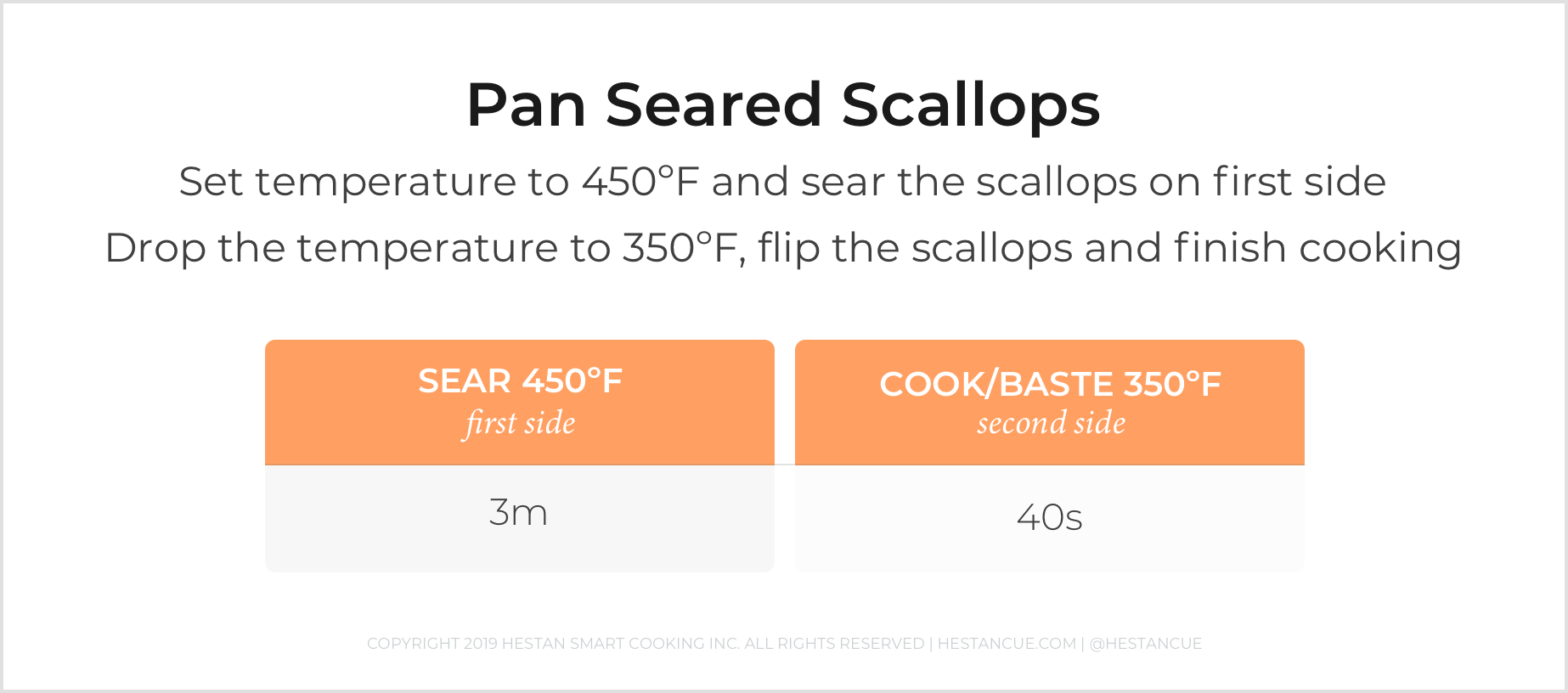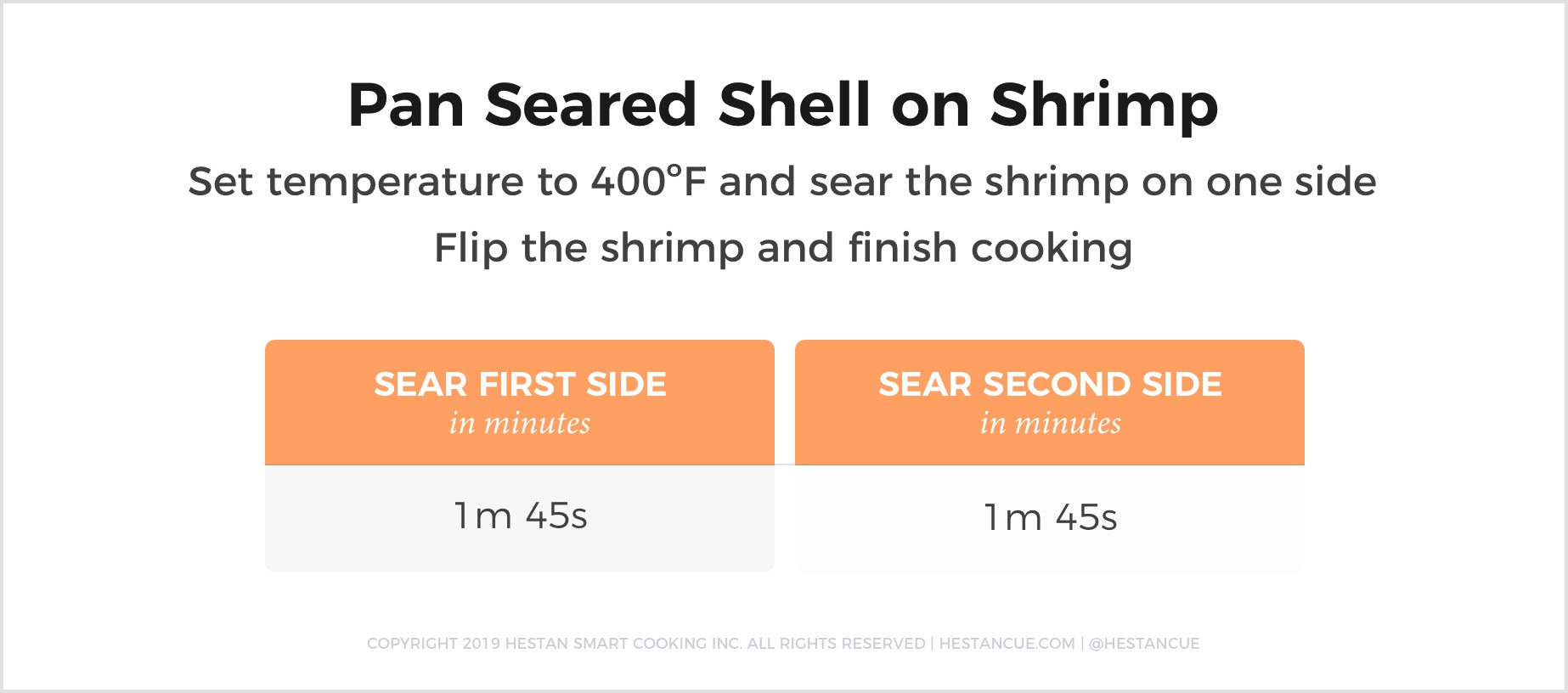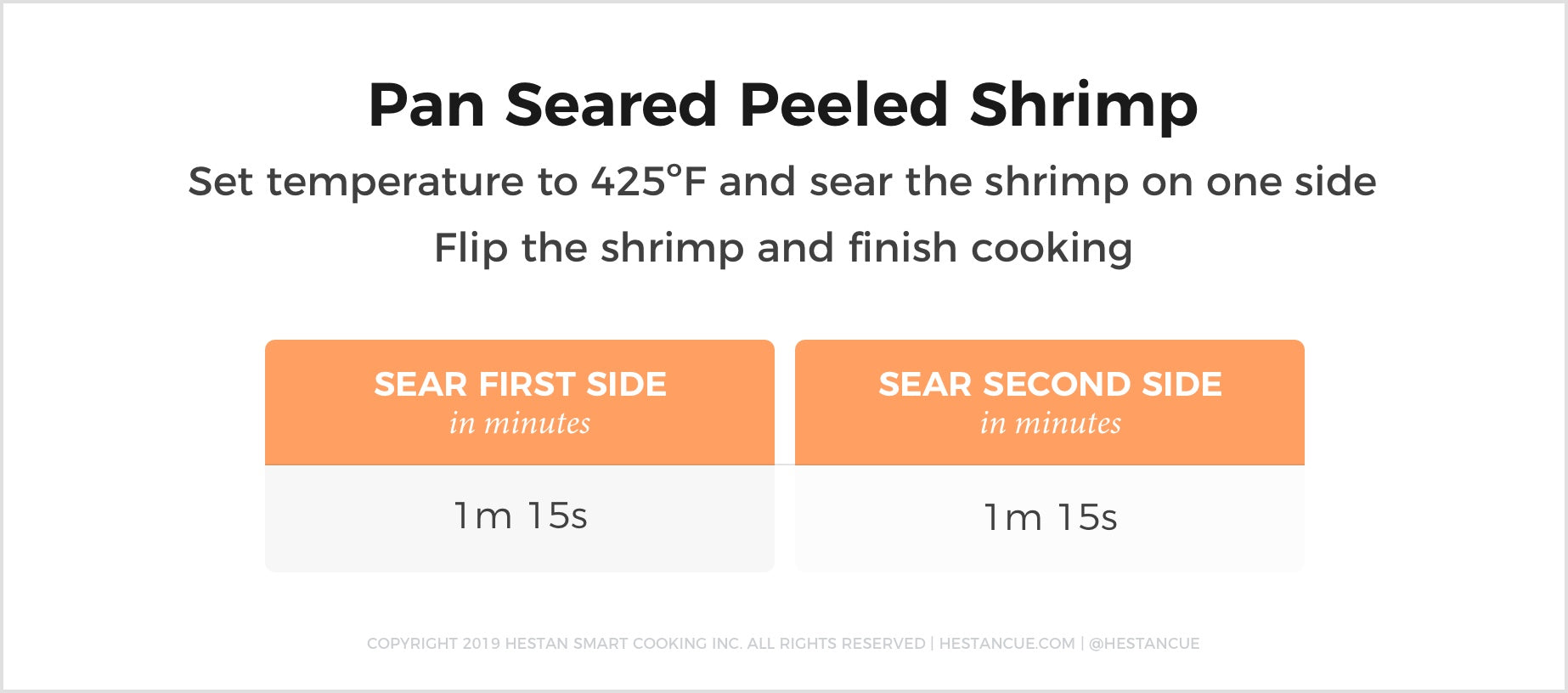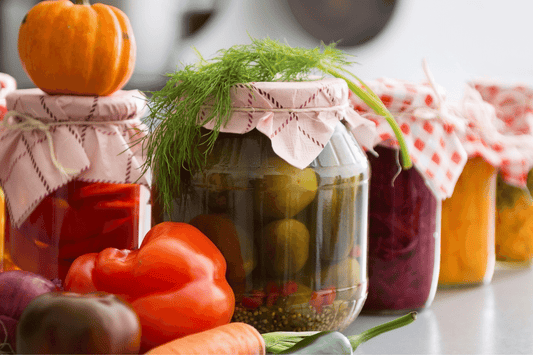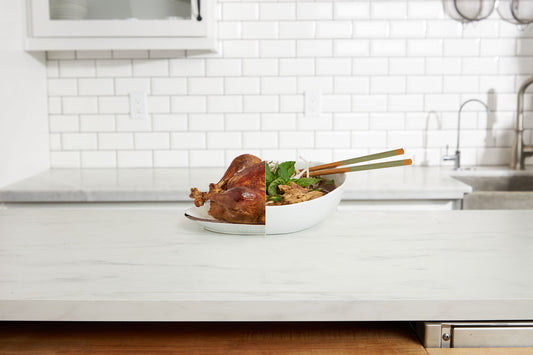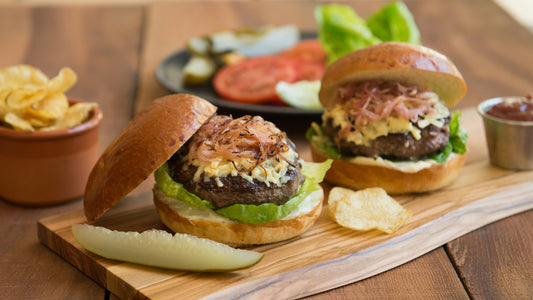Cooking Scallops and Shrimp in a Pan
When it comes to the bounty of the ocean, there are no two treasures as popular and tasty as scallops and shrimp. While seemingly simple to make, these restaurant favorites can actually be quite intimidating for many home cooks–but why? In both cases there is nothing more important in their preparation than time and temperature. If either one cooks for just a few seconds too long, the end result can be rubbery and somewhat tasteless, not to mention frustrating.
Though there are several ways to cook both shrimp and scallops; in this post we will focus on pan searing and the best temperatures and cooking times to optimize your culinary results. You can use these time and temp charts for cooking with Hestan Cue in control mode, or you can refer to the stovetop conversion chart in the FAQs if you don't have a cooking system with precise temperature control.
Quality Matters
A key thing to remember about fish and seafood in general, is that what comes out of the pan is only as good as what went into it. Essentially, quality is everything when it comes to crustaceans (shrimp) and mollusks (scallops).
When you journey to the seafood department at your local grocery store–or, if you are really lucky and have a local fish market–these are the key indicators that you should keep in mind when shopping for seafood:
- Smell. Don’t be scared to ask the fish monger for a sniff of the goods before purchasing. They should have a slightly "briney" and sweet smell. You might call it the smell of the deep sea. If you go in for a whiff, and automatically shudder, chances are it may be a chicken or steak kind of night.
- Shell-on or Shell-off. When buying shrimp, we suggest purchasing shell-on shrimp. You can always buy shell on and deveined shrimp or even peeled and deveined shrimp, but to maximize quality we find that shrimp that has been minimally processed, offers the best quality. Shrimp should also be firm to the touch, and have their shell intact.
- Freshness. If you notice black spots on the back of the head or down the back of the shrimp, chances are it is going to be a little funky. It is likely the shrimp or scallops that you are about to purchase have been previously frozen. There is absolutely nothing wrong with frozen seafood. However what does count is how the seafood were processed before freezing. This process is most crucial in dictating the quality of scallops.
- Wet Pack vs Dry Pack. In order to preserve scallops while fishing, fisherman will soak scallops in a phosphate solution that keeps the scallops hydrated before freezing. We refer to these as “wet packed” scallops. For the purposes of pan searing, we avoid “wet packed” scallops. The scallop acts like a sponge and retains all of the water and phosphates which make it nearly impossible to achieve a deep rich and golden brown crust when searing. For the best results, keep your eye out for “dry packed” scallops. Dry packed scallops skip the process of soaking in the phosphate solution and are sent directly to be frozen after being harvested. If you happen to be one of the lucky people who have access to fresh scallops, store them covered over ice in the refrigerator until it is time to cook. If either the scallops or shrimp look like they are somewhat soggy or falling apart, chances are they are on their last leg and should be avoided. A quality scallop should feel slightly firm, and appear somewhat dry. If it looks like a shapeless pale amoeba, take a hard pass.
- Sourcing. Last but not least, look into how the shrimp or scallops were sourced. This is more of an ethical dilemma that doesn’t really focus on the end culinary result, but instead gives a peace of mind that you are sourcing ingredients responsibly. For example scallops can be harvested by either trawling or hand harvested by a diver. The former involves dragging heavy nets across the bottom of the sea floor, destroying not only the seafloor environment, but other species as well. For more information on sustainable seafood check out, Monterey Bay Aquarium: Seafood Watch.
To Brine or Not to Brine? (The Answer is TO Brine)
Scallops naturally act like small sponges that absorb and hold onto large amounts of water which can make achieving that restaurant quality sear difficult. If you are using “wet packed” scallops, you can forget about getting any kind of color when searing. Once the scallop hits the pan and starts to release all of its water you end up with a steamy mess and rubbery scallops. In this case brining can really save the day.
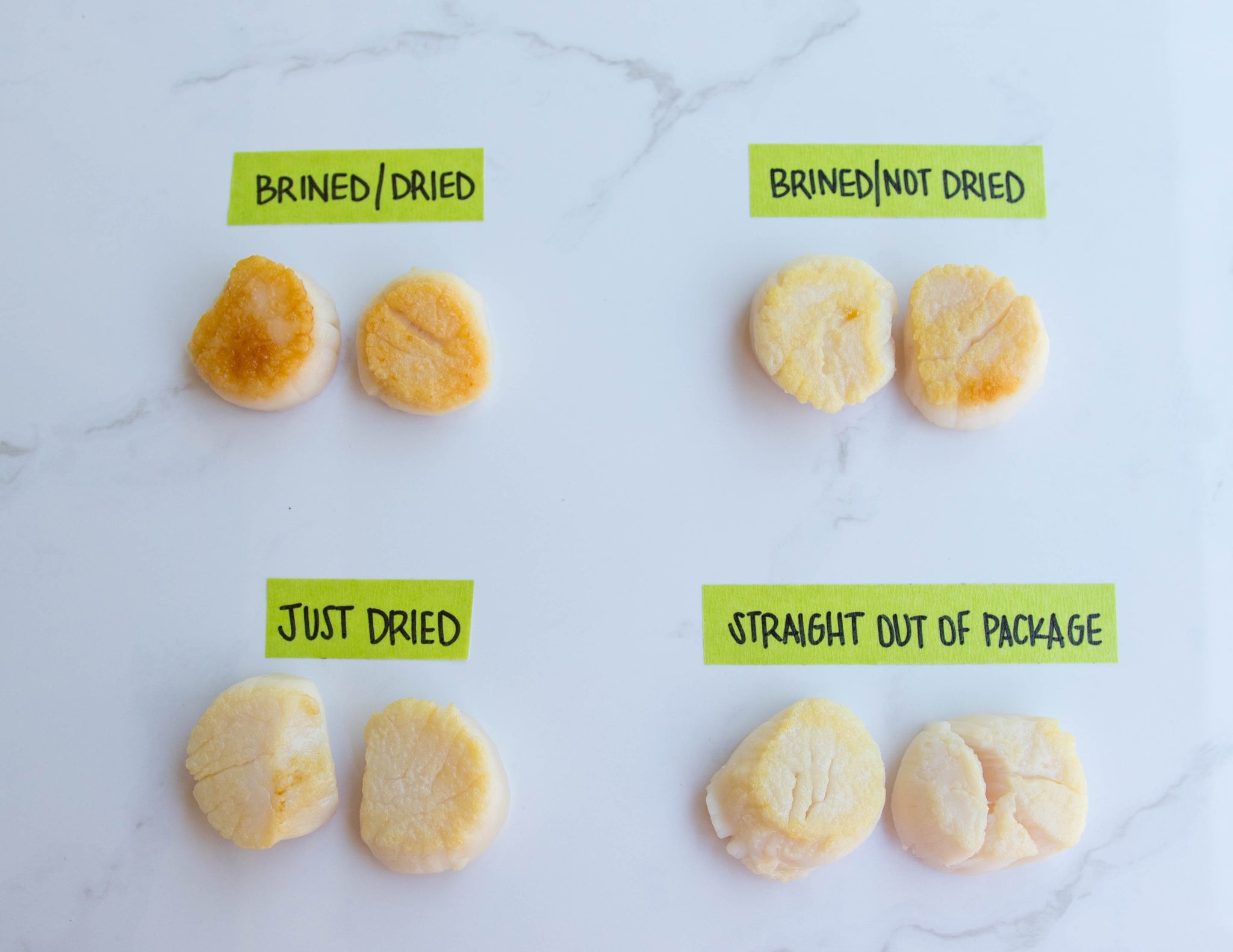
What is the brine actually doing that makes searing scallops so much better? For our scallop brine we use a 5% solution of kosher salt to water (5.5 tbsp of salt to 4 cups water). We recommend submerging the scallops for 10 minutes, then removing and air drying. Brining not only adds salinity to the scallops which in turn brings out the natural sweetness, but also helps to pull out excess moisture from the inside of the scallop. It sounds counter intuitive, but it absolutely makes a difference. Even when brining we still suggest using “dry packed” scallops vs “wet packed” scallops.
Does Size Matter?
When buying shrimp or scallops, there are several ways to define the size. For example, you might see the numbers 16-20 on the shrimp delay. For pan searing shrimp we have found that the 16-20’s are the most common size found in grocery stores, therefore we are providing the cooking times and temperatures for this size. We recommend cooking six shrimp in your pan at one time.
You might also see U-10 scallops on display. This indicates that there are under 10 scallops per pound, which would further indicate that the scallops are relatively large. These larger scallops are often referred to as Sea Scallops or Diver Scallops and are perfect for searing. Much smaller scallops like Bay Scallops are not really suitable for pan searing since they are a fraction of the size of Sea Scallops. For pan searing scallops we recommend searing up to eight U-8’s and U-10’s at one time. After cooking over four hundred scallops we found that most fall between U-8’s and U- 10’s, which both happen to have the same cooking times and temperatures.
Cooking Methods for Scallops and Shrimps
It doesn’t matter if you are cooking scallops for the first time or if you are a seasoned line cook, there is a huge sense of satisfaction when you go to flip the scallop and there is a deep golden brown crust waiting for you. The key difference in the way that we approach cooking shrimp vs. scallops are the times and temperatures. Even when cooking shrimp we have shell on shrimp vs. shell off or peeled shrimp. Let’s address cooking scallops first. For the step by step recipe, refer to our How to Pan Sear Scallops and How to Pan Sear Shrimp.
Cooking Time & Temperature for Pan Seared Scallops
First we start off by preheating the pan to 450°F (232°C). We want the pan to be hot enough to cause evaporation of any surface moisture on the scallop and begin the browning process.
After adding the scallops to the pan, it is crucial to not poke, prod, or move the scallops around until it is time to flip.
Once the scallop has developed a dark crust (3 minutes), it is time to give them a flip. At this point we want to dramatically decrease the temperature to 350°F(176°C).
We don’t want to sear the second side of the scallops, but instead gently cook the scallops until they are opaque in color. While the scallops finish cooking, feel free to add some garlic and thyme (or your favorite aromatics) to the pan.
Spooning the aromatic oil over the scallops adds a depth of flavor and helps to finishing cooking. The second side of the scallop should only cook for about 40 seconds.
As a side note, if you are trying to impress a special someone or you are having friends over for dinner, pan seared scallops paired with our Beurre Blanc sauce will not only taste delicious, but will automatically upgrade you to gourmand status amongst your peers.
Cooking Time & Temperature for Pan Seared Shrimp
When it comes to shrimp, pan searing is about as straightforward as it gets. There is a slight difference in time and temperature as we move from shell on shrimp to peeled shrimp. In both occasions we will only be cooking at one temperature.
For searing shell on shrimp, we are going to cook at a slightly lower temperature of 400°F (204°C). Cooking at a lower temp allows the shrimp to slightly steam in the shell, resulting in a very tender and sweet piece of shrimp.
Once you have added the shrimp to the pan, all you have to do is cook for the same amount of time on both sides at the same temperature.
Pan searing peeled shrimp follows the same process, but at a higher temperature of 425°F (218°C) for 1 minute and 15 seconds per side. Using this technique allows for multiple textures to develop within the shrimp. The outside should have a slight crunch or firmness, while the interior should be supple and tender.
We strongly recommend giving both techniques a try. And we always suggest deveining your shrimp by removing the digestive tract from the back of the shrimp. It can impart a bitter flavor and grittiness to your shrimp.
FAQs for Cooking Shrimp or Scallops in a Pan
Can I cook my Shrimp and Scallops directly from the freezer?
No, these times and temperatures are designed for Shrimp and Scallops that have been thawed. If using frozen Shrimp and Scallops, we suggest allowing them to thaw overnight in the refrigerator.
When should I season my Shrimp and Scallops?
We suggest seasoning right before adding to the pan. Salting your Scallops before will begin to pull out moisture which can have a negative impact and may cause sticking or poor browning.
Do I need to baste the Scallops?
No, it is not necessary, but in general, basting can seriously help cook your Scallops more evenly, and we highly recommend doing so. Plus, basting with aromatics in the pan is a restaurant style technique that adds flavor and is sure to impress your friends and family.
Can I add aromatics, like thyme, rosemary, or garlic to the pan?
Absolutely! Adding herbs and other aromatics to your cooking oil adds a depth of flavor.
Does my Shrimp or Scallops need to rest after cooking?
No. Seared scallops and shrimp are at their tastiest right after cooking.
Check out the Hestan Cue app for iOS and Android to learn more about precision cooking with Cue, and all the things you can do! If you found this guide helpful, please let us know–we would love to hear your feedback.
Keep us posted with photos of your experiments and share your results and #CueTips with the community!


